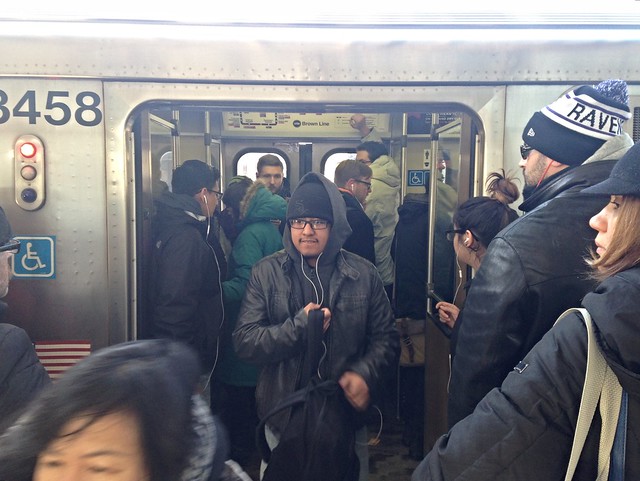Today the CTA released some generally good news about ridership, heralding 2015 as the highest-ever recorded year for rail use. Meanwhile there was only a minor dip in bus ridership compared to last year, which means a three-year decline in bus use is leveling off.
The total number of rail and bus rides in 2015 was 516 million, up 1.6 percent from 514.5 million last year. This was the eighth year in a row that there were more than half a billion total rides.
As usual, in 2015 bus rides made up the majority of the ridership, with 274.3 million rides, down 0.6 percent from 276 million in 2014. That’s a much smaller decline from the previous year compared to the 8 percent drop that occurred in 2014, and the 3 percent dip that happened in 2013.
The transit agency blamed some of the bus ridership decline on the cold, snowy weather the city experienced in February of 2015, as well as downtown construction for projects like the Loop Link bus rapid transit system and the Washington-Wabash ‘L’ station. However, bus ridership increased on several routes, including ones in Evanston, near Midway Airport, and on the Far South Side.
In 2015 rail ridership hit 241.7 million, a 1.6 percent increase from the previous year’s record of 238 million rides. The CTA noted that this happened in spite of the shutdown of the Yellow Line for several months dues to an embankment collapse caused by a nearby construction project.
Thanks in part to the opening of the Cermak/McCormick Place station in February 2015, the Green Line South saw the highest ridership bump, with an 11.2 percent increase. The new stop had more than 390,000 station entries last year.
Other lines that had high ridership growth included the Blue Line O’Hare branch, which rose 5.3 percent; the Blue Line subway, which increased 4.6 percent, and the Red Line subway, which increased 4.3 percent from the previous year. These ridership increases reflect recent housing trends, as many newcomers are moving to the Milwaukee Avenue and North Red Line corridors, and a high percentage of the recent arrivals are transit commuters.
The CTA credited the general rise in transit ridership to the more than $5 billion in projects that have been completed, are underway, or are planned to improve service. Some recent ones include the launching of Loop Link (although its performance has been unimpressive so far), the new Ventra app, the return of express bus service on Ashland and Western, the addition of 4G wireless to all of the CTA’s subways, and work to rebuild the 95th Street and Wilson Red Line stations.
The transit agency said the migration of customers from bus to rail reflects a national trend. Riders prefer transit modes that aren’t impacted by traffic jams, and they appreciate weather-protected stations.
The continuing growth in Chicago rail ridership and the decline in bus use seems to be an argument for two hotly contested project. The Belmont flyover, which would unclog the junction of Red, Purple, and Brown tracks north of Belmont Avenue, would allow for the CTA to provide eight more Red Line trains, carrying, 7,200 more riders, per hour during peak times. And the Ashland Avenue bus rapid transit project would nearly double bus speeds, while providing customers with ‘L’ station-like bus platforms.
![]()
Did you appreciate this post? Streetsblog Chicago is currently funded until April 2016. Consider making a donation through our PublicGood site to help ensure we can continue to publish next year.




